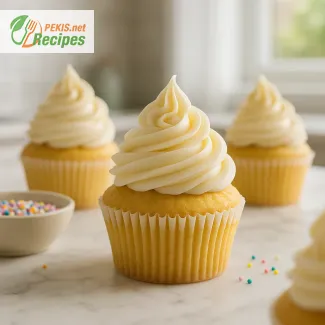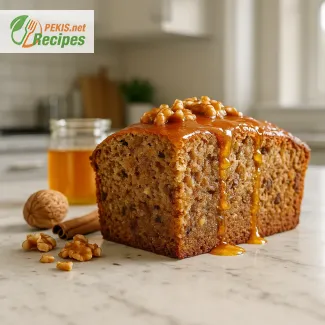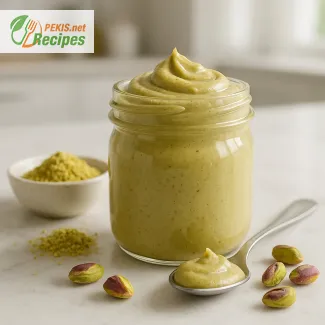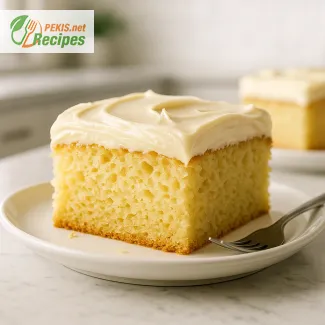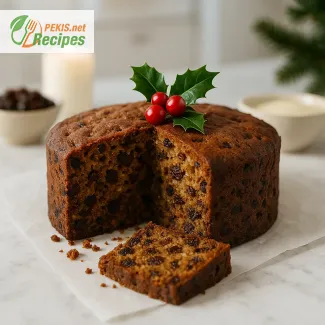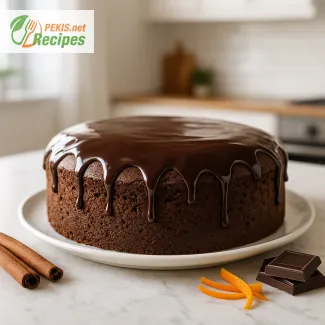Perfect Christmas Potica delivers 12 servings in just under 3 hours (prep 40 min, rise 90 min, bake 55 min). This festive Slovenian nut roll combines a soft, buttery yeast dough with a creamy walnut-honey filling, creating a swirl of sweetness and spice in every slice. The rich blend of cinnamon, vanilla, and rum adds warmth and depth, making it an unforgettable centerpiece for holiday gatherings. Potica keeps beautifully for 5 days at room temperature or 2 months frozen, staying moist and aromatic for every celebration.
PEKIS – a professional chef and recipe developer with over 25 years of experience in baking and cooking, specialized in European and international cuisine. I’ve spent countless holidays perfecting traditional desserts like Potica, learning how a gentle hand, warm milk, and the right balance of walnuts and honey can transform this classic Slovenian roll into something truly special for Christmas.
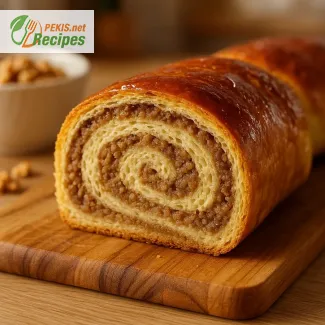
Secrets to a Flawless Holiday Potica: Tradition Meets Perfection
How to Achieve the Ideal Texture, Aroma, and Walnut Filling Balance
Few holiday desserts embody heritage and craftsmanship quite like Potica, Slovenia’s iconic rolled pastry layered with rich walnut filling and infused with the warmth of honey, butter, and festive spices. Each slice tells a story of centuries-old traditions, passed down through generations, where families gather to prepare the perfect dough, roll it with care, and bake it until golden brown. Creating a perfect Christmas Potica is not just about technique—it’s about rhythm, patience, and understanding how every ingredient behaves under your hands.
The ideal Potica texture balances softness and lightness in the dough with the dense richness of the nut filling. Achieving this begins long before baking—starting with the yeast activation, the choice of flour strength, and how you incorporate butter and milk to keep the dough elastic yet delicate. Proper kneading develops just enough gluten for flexibility, while gentle proofing allows it to rise evenly without losing its buttery tenderness.
Potica’s signature flavor lies in the filling of crushed walnuts, honey, cinnamon, and cream, which melts slightly during baking, fusing the layers together. Each roll reveals a swirl of sweetness and spice that embodies Christmas warmth. Whether baked in a traditional clay mold or a bundt-style pan, the scent that fills the kitchen is unmistakably festive.
The Heritage and Origin of Potica
Originating in Slovenia, Potica (pronounced po-tee-tsa) is one of the most treasured Central European festive desserts. Its roots date back to the 16th century, when it symbolized abundance and celebration during Easter and Christmas. Historically, every Slovenian household had its own variation—some filled it with walnuts, poppy seeds, or tarragon, while others added local honey and dried fruit. The recipe has since transcended borders, becoming a beloved holiday classic among Slovenians worldwide.
Today, the Christmas Potica represents a culinary bridge between past and present. Its combination of fluffy yeast dough and fragrant nut filling continues to captivate bakers seeking a dessert that is both rustic and refined.
Why You’ll Love This Christmas Potica
- Rich, buttery aroma that fills your kitchen and evokes festive nostalgia.
- Perfectly balanced texture, soft dough with a moist, nutty swirl inside.
- Timeless tradition — a dessert that connects generations at the table.
- Customizable filling options, from walnuts to almonds or hazelnuts.
- Make-ahead friendly, perfect for busy holiday baking schedules.
The Science of Soft and Nutty Perfection
Achieving that signature softness comes down to understanding ingredient behavior.
- Butter and milk provide moisture and richness, ensuring a soft crumb.
- Egg yolks add structure and color, helping the dough stay supple.
- Honey enhances the flavor while keeping the pastry moist for days.
- Walnuts, when finely ground and lightly toasted, release natural oils that blend harmoniously with sugar and cream, creating a velvety filling.
The layering process is just as important. Spread the filling evenly but not too thickly, allowing the dough to roll without cracking. A careful, slow bake—never rushed—lets the inside cook through without drying the crust.
Related Traditional Recipe
You can also explore the authentic Walnut Potica (Slovenian Nut Roll), a traditional version that inspired this Christmas classic:
Walnut Potica (Slovenian Nut Roll) – Traditional Slovenian Recipe
Storage and Make-Ahead Tips
Because of its butter-rich dough and moist filling, Potica stays tender for several days when stored properly.
- Wrap the cooled roll in parchment and keep it in an airtight tin at room temperature for up to 5 days.
- For longer storage, freeze whole or sliced portions for up to 2 months, wrapping each piece in plastic and foil.
- To serve again, warm slightly in a low oven (about 120°C / 250°F) to restore its softness and aroma.
You can also prepare the dough and filling a day in advance, refrigerate overnight, and assemble the roll the next morning. This not only saves time but enhances the flavor as the dough matures slowly.
Creative Variations for Modern Bakers
Traditional doesn’t have to mean predictable. Once you master the base technique, you can experiment with modern twists while respecting the essence of Potica:
- Chocolate walnut filling for a deeper, richer flavor.
- Orange zest and cardamom for a refreshing, fragrant touch.
- Pistachio and honey for a Mediterranean-inspired fusion.
- Vegan version with plant-based milk and margarine, keeping the same soft texture.
- Mini Poticas baked in individual molds — perfect for gifting or elegant dessert tables.
The Sensory Experience
When sliced, the ideal Potica reveals delicate, even spirals, shimmering slightly from the glaze of honey and butter brushed on top. The aroma of warm nuts, caramelized sugar, and vanilla evokes both home and holiday. Each bite offers a contrast between the tender dough and creamy walnut swirl, reminding you why this dessert has endured for centuries.
The process may seem intricate, but with the right rhythm, Potica becomes meditative—a celebration of patience rewarded with the perfect soft and nutty perfection every Christmas table deserves.
- Activate the yeast:
Warm the milk gently (about 35–40°C / 95–105°F). Add a pinch of sugar and yeast, stir, and let it rest for 10 minutes until foamy. This ensures proper yeast activation for a light and airy dough. - Prepare the dough:
In a large bowl, mix flour, sugar, and salt. Add the yeast mixture, egg yolks, butter, vanilla extract, and lemon zest. Knead for about 10 minutes until the dough becomes smooth and elastic. If it’s too sticky, sprinkle a bit more flour. - First rise:
Shape the dough into a ball, place it in a lightly greased bowl, cover it, and let it rise in a warm place for about 1 hour, or until doubled in volume. - Prepare the filling:
While the dough rises, combine the ground walnuts, sugar, cinnamon, and vanilla. Warm the milk with honey and butter, then pour it over the nut mixture. Stir until a smooth, spreadable filling forms. Add rum and let it cool slightly. - Roll out the dough:
Once the dough has risen, place it on a floured surface and roll it out into a rectangle about 0.5 cm thick. - Assemble the Potica:
Spread the filling evenly over the dough, leaving about 2 cm margin at the edges. Roll the dough tightly into a log from the longer side. Carefully transfer it into a greased bundt or loaf pan, seam side down. - Second rise:
Cover and let it rise again for about 30 minutes, allowing the roll to expand slightly. - Bake:
Brush with beaten egg, then bake in a preheated oven at 175°C (350°F) for about 50–55 minutes, until golden brown and firm. If the top browns too quickly, cover it loosely with foil. - Cool and finish:
Let it rest in the pan for 10 minutes, then remove and cool completely on a wire rack. Brush with warm honey for shine and dust lightly with powdered sugar before serving.
FAQ questionWhat flour works best for soft potica?
Use high-protein all-purpose flour (around 11–12% protein). It develops enough gluten for a stretchy, rollable dough without turning chewy. Sift the flour for better hydration, then knead until the dough is smooth and elastic (light windowpane). A touch of egg yolk, butter, and warm milk boosts tenderness and flavor while keeping the crumb soft for days.
FAQ questionHow warm should the liquids be for the yeast?
Aim for lukewarm milk at 95–105°F (35–40°C). This range activates yeast quickly without damaging it. Add a pinch of sugar to jump-start fermentation and wait until the mixture is foamy (about 10 minutes). If nothing happens, the yeast is likely inactive—start over to avoid a dense roll.
FAQ questionHow thin should I roll the dough and how much filling should I use?
Roll to 3–5 mm thickness; thinner tears, thicker won’t spiral well. Spread a thin, even layer of walnut filling, leaving a 2 cm border on the edges to prevent leaks. The goal is balanced layers—too much filling causes gaps and blowouts; too little yields a dry bite. If the filling feels stiff, loosen it with warm milk or honey until spreadable and glossy.
FAQ questionHow do I keep the spiral tight without cracking?
Work on a lightly floured surface and de-gas large bubbles before spreading the filling. Roll snugly but gently from the long side, then seal the seam and place it seam-side down in the pan. Give the dough a second rise (25–35 min) so the gluten relaxes; this prevents tearing and tunneling during baking. If the top tightens, score a shallow vent to control expansion.
FAQ questionWhat baking signs show potica is done (not raw inside)?
Bake at 175°C / 350°F for 50–55 minutes. Look for a deep golden crust, a dry, set seam, and a hollow sound when tapped. If you use a thermometer, the center should reach 92–94°C (198–202°F). If the crust browns too fast, tent with foil for the last 15 minutes to avoid drying the interior.
FAQ questionCan I make potica ahead and how do I store it?
Yes. Prepare the dough and filling the day before, refrigerate separately, and assemble in the morning; the cool rest improves flavor and handling. After baking, cool completely and wrap in parchment + an airtight tin. It keeps 5 days at room temperature, stays moist thanks to honey and butter, and freezes up to 2 months (whole or sliced). Rewarm briefly in a low oven to revive aroma and softness.
A perfect Christmas Potica captures everything comforting about the holidays — the warmth of freshly baked dough, the aroma of toasted walnuts, and the sweetness of honey and vanilla swirling through each delicate layer. Every step, from proofing the yeast to brushing the golden crust, builds anticipation for that first festive slice.
The beauty of Potica lies in its balance — tender dough that holds its shape yet melts in the mouth, and a rich filling that speaks of tradition and care. It’s not a dessert to rush; it’s one to craft with patience, to share with family, and to pass down like a story told around the table.
Each ingredient has purpose. Butter and milk bring softness, walnuts add natural oils and depth, while rum and cinnamon infuse warmth that lingers. Together, they create a pastry that feels alive — comforting, aromatic, and deeply nostalgic.
Making Potica each Christmas reconnects you with a tradition that transcends generations. Whether you bake it once a year or every season, its timeless charm remains. The golden crust, the swirl of flavor, and the quiet pride when it’s served — that’s the essence of home, heritage, and celebration in one beautiful roll.
Allergens present in the recipe:
- Gluten (flour)
- Eggs
- Milk (butter, milk)
- Tree nuts (walnuts)
Substitution tips for allergens:
- Replace wheat flour with gluten-free flour blend (add 1 tsp xanthan gum for elasticity).
- Use plant-based milk (almond, oat, or soy) instead of cow’s milk.
- Replace butter with vegan margarine or coconut oil.
- Use a flaxseed egg (1 tbsp ground flaxseed + 3 tbsp water) instead of eggs.
- For nut allergies, replace walnuts with sunflower seeds or pumpkin seeds.
- Vitamin B1 (Thiamine) – 0.12 mg: supports energy metabolism.
- Vitamin B2 (Riboflavin) – 0.15 mg: contributes to cell growth.
- Vitamin E – 1.5 mg: antioxidant that protects cell membranes.
- Calcium – 60 mg: essential for bone and muscle health.
- Iron – 1.8 mg: helps oxygen transport in the blood.
- Magnesium – 45 mg: supports nerve and muscle function.
- Phosphorus – 110 mg: contributes to energy metabolism.
- Potassium – 180 mg: maintains proper heart and muscle function.
- Polyphenols (from walnuts) – 250 mg: protect against oxidative stress.
- Flavonoids (from honey and cinnamon) – 60 mg: support cardiovascular health.
- Vitamin E (natural antioxidant) – 1.5 mg: combats free radicals and supports skin health.
- Phenolic acids (from flour and nuts) – 40 mg: help reduce inflammation.
